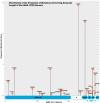Mutational Landscape and Interaction of SARS-CoV-2 with Host Cellular Components
- PMID: 34576690
- PMCID: PMC8464733
- DOI: 10.3390/microorganisms9091794
Mutational Landscape and Interaction of SARS-CoV-2 with Host Cellular Components
Abstract
The emergence of severe acute respiratory syndrome coronavirus 2 (SARS-CoV-2) and its rapid evolution has led to a global health crisis. Increasing mutations across the SARS-CoV-2 genome have severely impacted the development of effective therapeutics and vaccines to combat the virus. However, the new SARS-CoV-2 variants and their evolutionary characteristics are not fully understood. Host cellular components such as the ACE2 receptor, RNA-binding proteins (RBPs), microRNAs, small nuclear RNA (snRNA), 18s rRNA, and the 7SL RNA component of the signal recognition particle (SRP) interact with various structural and non-structural proteins of the SARS-CoV-2. Several of these viral proteins are currently being examined for designing antiviral therapeutics. In this review, we discuss current advances in our understanding of various host cellular components targeted by the virus during SARS-CoV-2 infection. We also summarize the mutations across the SARS-CoV-2 genome that directs the evolution of new viral strains. Considering coronaviruses are rapidly evolving in humans, this enables them to escape therapeutic therapies and vaccine-induced immunity. In order to understand the virus's evolution, it is essential to study its mutational patterns and their impact on host cellular machinery. Finally, we present a comprehensive survey of currently available databases and tools to study viral-host interactions that stand as crucial resources for developing novel therapeutic strategies for combating SARS-CoV-2 infection.
Keywords: RNA-binding proteins; SARS-CoV-2; host interaction; mutation; structural proteins; variants.
Conflict of interest statement
Authors declare no conflict of interest.
Figures


Similar articles
-
Uncovering the impact of SARS-CoV2 spike protein variants on human receptors: A molecular dynamics docking and simulation approach.J Infect Public Health. 2023 Oct;16(10):1544-1555. doi: 10.1016/j.jiph.2023.07.011. Epub 2023 Jul 24. J Infect Public Health. 2023. PMID: 37566991
-
SARS-CoV-2 Evolutionary Adaptation toward Host Entry and Recognition of Receptor O-Acetyl Sialylation in Virus-Host Interaction.Int J Mol Sci. 2020 Jun 26;21(12):4549. doi: 10.3390/ijms21124549. Int J Mol Sci. 2020. PMID: 32604730 Free PMC article. Review.
-
The British variant of the new coronavirus-19 (Sars-Cov-2) should not create a vaccine problem.J Biol Regul Homeost Agents. 2021 Jan-Feb;35(1):1-4. doi: 10.23812/21-3-E. J Biol Regul Homeost Agents. 2021. PMID: 33377359
-
Characterization and functional interrogation of the SARS-CoV-2 RNA interactome.Cell Rep. 2022 Apr 26;39(4):110744. doi: 10.1016/j.celrep.2022.110744. Cell Rep. 2022. PMID: 35477000 Free PMC article.
-
Current status of antivirals and druggable targets of SARS CoV-2 and other human pathogenic coronaviruses.Drug Resist Updat. 2020 Dec;53:100721. doi: 10.1016/j.drup.2020.100721. Epub 2020 Aug 26. Drug Resist Updat. 2020. PMID: 33132205 Free PMC article. Review.
Cited by
-
A comprehensive analysis of gene expression profiling data in COVID-19 patients for discovery of specific and differential blood biomarker signatures.Sci Rep. 2023 Apr 5;13(1):5599. doi: 10.1038/s41598-023-32268-2. Sci Rep. 2023. PMID: 37019895 Free PMC article.
-
Long-Term Kinetics of SARS-CoV-2 Antibodies and Impact of Inactivated Vaccine on SARS-CoV-2 Antibodies Based on a COVID-19 Patients Cohort.Front Immunol. 2022 Jan 27;13:829665. doi: 10.3389/fimmu.2022.829665. eCollection 2022. Front Immunol. 2022. PMID: 35154152 Free PMC article.
-
Experimental and computational methods for studying the dynamics of RNA-RNA interactions in SARS-COV2 genomes.Brief Funct Genomics. 2024 Jan 18;23(1):46-54. doi: 10.1093/bfgp/elac050. Brief Funct Genomics. 2024. PMID: 36752040 Free PMC article. Review.
-
Spike protein of SARS-CoV-2 variants: a brief review and practical implications.Braz J Microbiol. 2022 Sep;53(3):1133-1157. doi: 10.1007/s42770-022-00743-z. Epub 2022 Apr 9. Braz J Microbiol. 2022. PMID: 35397075 Free PMC article. Review.
-
miRNAs: The Key Regulator of COVID-19 Disease.Int J Cell Biol. 2022 Oct 29;2022:1645366. doi: 10.1155/2022/1645366. eCollection 2022. Int J Cell Biol. 2022. PMID: 36345541 Free PMC article. Review.
References
Publication types
Grants and funding
LinkOut - more resources
Full Text Sources
Miscellaneous

